Beta Glucan Market Size
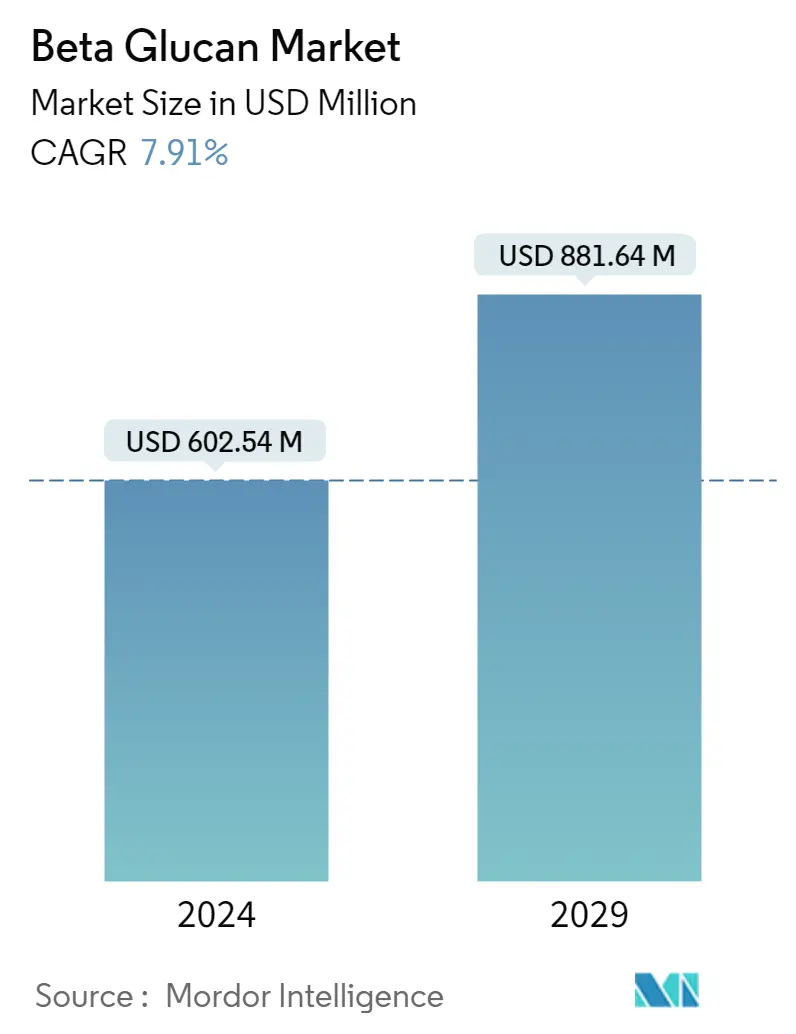
| Study Period | 2019 - 2029 |
| Market Size (2024) | USD 602.54 Million |
| Market Size (2029) | USD 881.64 Million |
| CAGR (2024 - 2029) | 7.91 % |
| Fastest Growing Market | Asia Pacific |
| Largest Market | Europe |
Major Players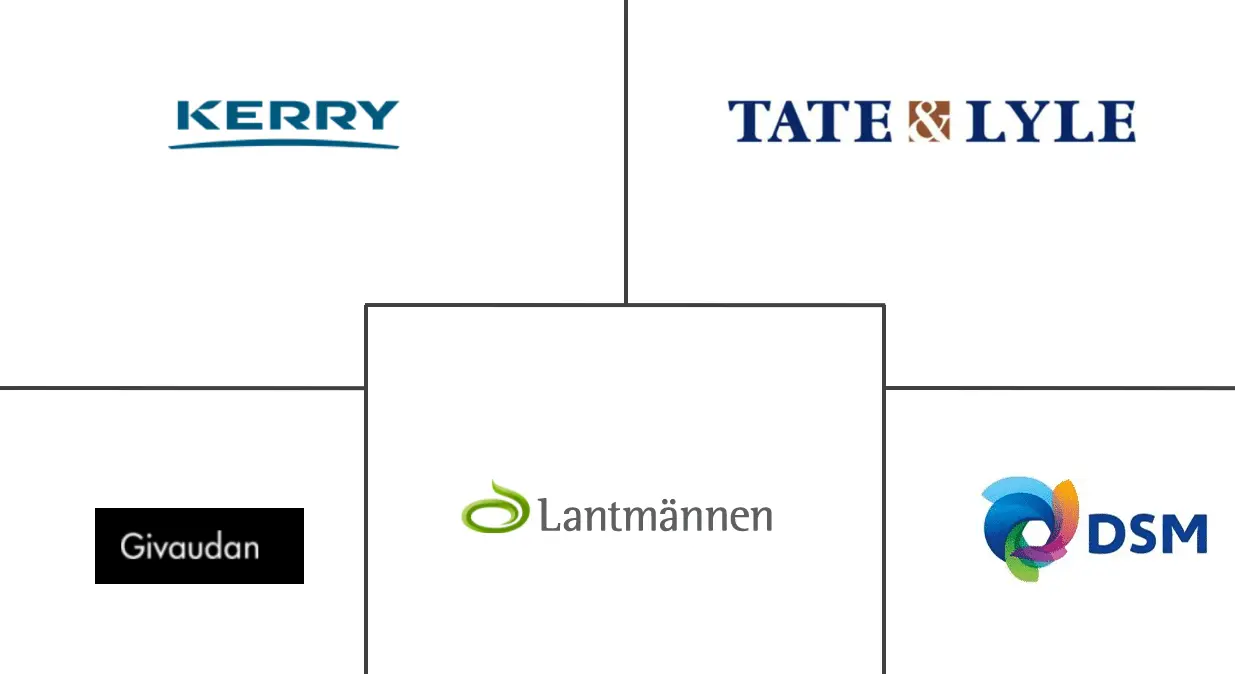
*Disclaimer: Major Players sorted in no particular order |
Beta Glucan Market Analysis
The Beta Glucan Market size is estimated at USD 602.54 million in 2024, and is expected to reach USD 881.64 million by 2029, growing at a CAGR of 7.91% during the forecast period (2024-2029).
COVID-19 pandemic is still transforming the growth of numerous industries, the outbreak's immediate impact is varied. While some sectors may experience a decline in demand, many others continue to stay unaffected and exhibit strong development prospects. The global beta-glucan market has been witnessing significant growth due to the increasing health and hygiene consciousness among consumers globally, owing to the impact of the COVID-19 pandemic. Consumers have grown more mindful of their health and proactive about maintaining it through healthy living. As a result, consumer demand has shifted from processed food to nutritious, low-calorie, non-oily, functional, and superfoods. Consumers have become more conscious of food ingredients and pay close attention to nutrition labels and product contents. This shift in consumer behavior has increased demand for healthy foods and supplements, prompting various producers to introduce new functional, non-genetically modified, and naturally produced food products.Furthermore, changing lifestyles, recovering economies, and shift toward natural products have been observed in developing economies, leading to the growth in demand for beta-glucan, not only in food & beverage, personal care, and pharmaceutical products but also in other industrial applications, including animal feed, cosmetics, and biofuel production.
Over the long term,Beta-glucans are biologically active fibers derived from the cell wall of various natural sources, including yeast, mushroom, oats, barley, and others, with the proven benefits for health and medical significance. The beta-glucans are allowed in several countries, including the United States, Canada, Finland, Sweden, China, Japan, and Korea, as potent immunological activators. Beta-glucans are not synthesized by the human bod. Hence, these are recognized by the immune system, and these induce both adaptive and innate immune responses.Currently, the available beta-glucan is sold for providing health benefits, such as the wellness of the cardiac system, immune system, digestive system, and others. For example, Leiber GmbH, a German manufacturer, offers a varied range of specialized yeast products, including Yestimun. Yestimun is an 85% pure beta-glucan derived from brewer's yeast. Beta-glucan is used for digestive health by triggering an immune-modulating response.Some of the players operating in the beta-glucan market are Tate & Lyle PLC, Kerry Group PLC, Koninklijke DSM NV, Super Beta-Glucan, Lantmännen, among others.
Beta Glucan Market Trends
This section covers the major market trends shaping the Beta Glucan Market according to our research experts:
Fungi has the Highest Content of Beta Glucan
Fungi immunoceuticals, mainly polysaccharides, such as β-D glucans, with antitumor and immunomodulatory effects, proceeded successfully through clinical trials and are used to treat cancer and chronic diseases. Thus, manufacturers are focusing on offering beta-glucans sourced from fungi as they are mainly known for their immune-modulating and various other disease-curing properties. In the healthcare field, mushroom beta-glucan is used to carry out research studies to identify its potential uses for human health. For example, research studies have been carried out to study the effect of mushroom beta-glucans on tumor inhibition in mice with tumors by providing oral administration of mushroom beta-glucan with radiation therapy. While the awareness of beta-glucans from sources like barley, oats, are quite high, beta-glucan sourced from mushroom can provide unique opportunities for researchers to discover novel bioactive with functional food potential. The ingredient is gaining traction for cosmetic applications as it is more moisturizing than hyaluronic acid and improves moisture levels in the skin with continued use. For example, Kosmetic Immunity by JKosmmune uses beta-glucan derived from mushrooms in its skincare products to boost and protect skin barriers while moisturizing skin. Moreover, with rising clinical studies regarding yeast as a nutritional source, GN Corporation launched Nichi Glucan, which is derived from Aureobasidium (black yeast). It contains beta-D-glucans that are the active compounds found in the cell walls of yeast, fungi, and seaweed. Beta-D-glucans, also known as biological response modifier glucans (BRMGs), have been well documented in animal and human studies for improving insulin sensitivity, increasing satiety, and reducing cholesterol serum levels. Thus, these innovations are supporting the growth of the market studied.
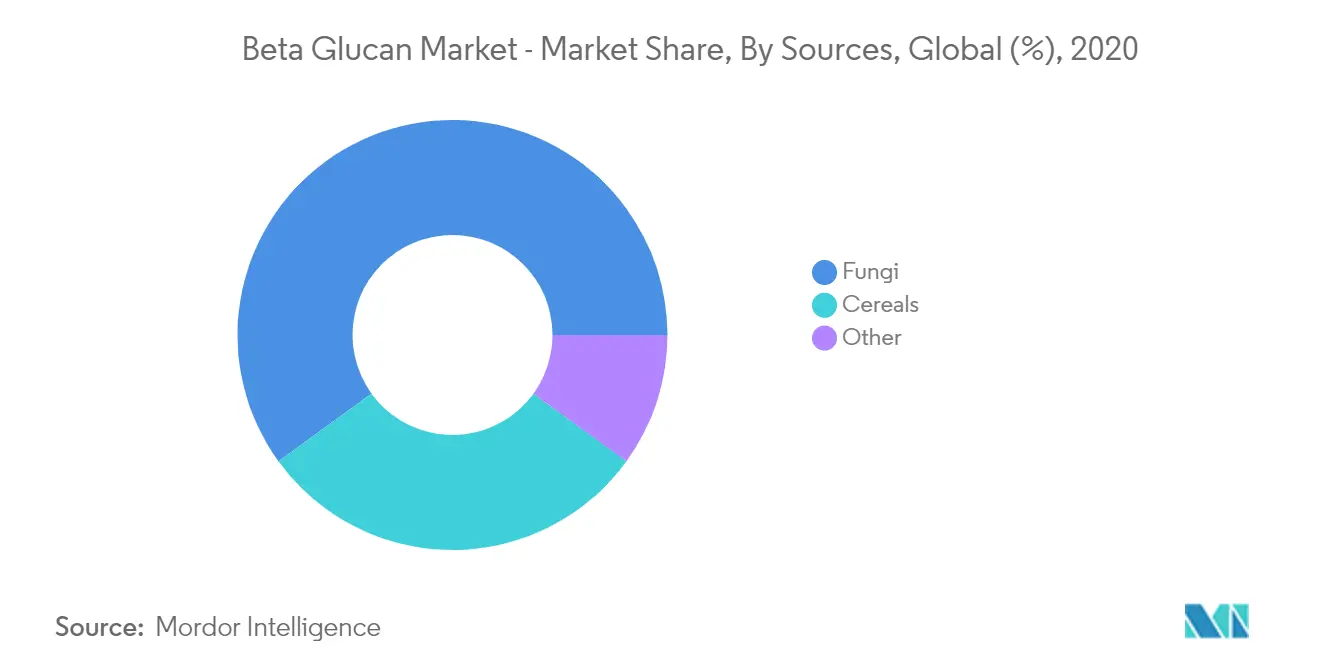
Europe is the Largest Market
Owing to the health benefits, and other beneficial properties of beta-glucan, this fiber ingredient has been gaining popularity across industries including food & beverage, nutraceuticals, pharmaceuticals, animal feed, and cosmetics, among others. In the United Kingdom, the increasing product innovations in the cosmetics industry are expected to drive the demand for yeast beta-glucan for cosmetic applications. For instance, yeast beta-glucan provides the traditional moisturizing agent, and it acts as a natural repairing agent, compared to the conventional oat beta-glucan.Furthermore, in contrast to the relatively inexpensive commercially available beta-glucans from yeast, mushroom beta-glucans have been scientifically proven to have more diverse structures and consequently, superior immunological activity, thereby making them ideal for medicinal applications. Additionally, the sensitivity of consumers toward a healthy diet and its benefits for health and longevity is increasing. Food products containing nutritional substances such as vitamins, fibers, and antioxidants, among others, are often laborious to prepare and consume, discouraging those who have little time to devote to cooking and a hectic schedule. For these reasons, the formulation of products for easy and immediate consumption (like baked goods) that add value to consumers' diets is essential. Hence, food and beverage manufacturers have been increasingly using beta-glucan in baked products, dressings, cereals, meat and meat products, and other edible goods. For instance, Pastificio Granoro, one of the most prominent Italian food manufacturers, employs high beta-glucan content in its products including spaghetti and pasta, owing to the nutritional properties of the fibrous ingredient and the health benefits associated.
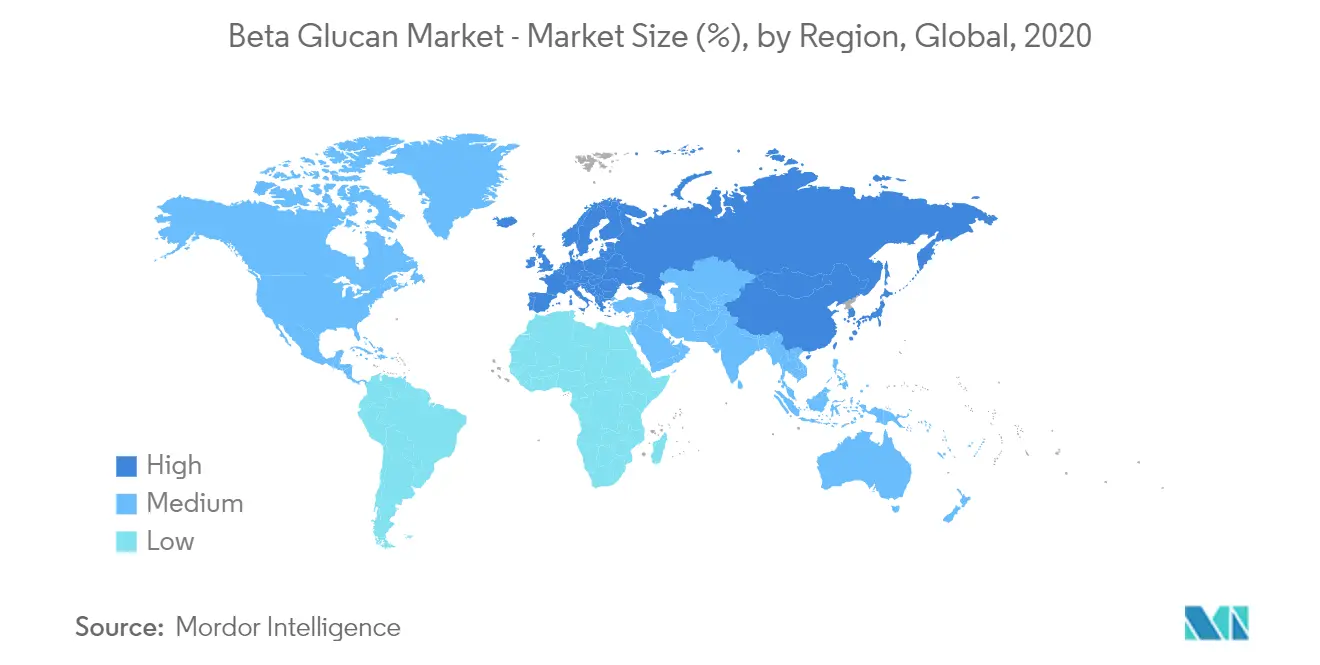
Beta Glucan Industry Overview
The most active companies in the global beta-glucan market include key players like Lallemand Inc., Merck KGaA, Lesaffre International, and Ceapro Inc. The major players of the market have been indulging in strategies like product innovation, mergers, acquisitions, partnerships, and production and geographical expansions, which in turn has leveraged them to gain an esteemed position in the market. Product innovation is the most adopted strategy by the key players operating in the global beta-glucan market. The extensive investment in R&D was witnessed in the past years, which has led to the introduction of numerous new products to hit the market studied.Agreements with government research centers under development programs, financial assistance and collaboration with the universities for utilizing their research facilities, and partnerships with distributors are also some of the major strategies adopted by the players in the market
Beta Glucan Market Leaders
-
Tate & Lyle
-
Lantmännen
-
Kerry Group
-
Koninklijke DSM N.V.
-
Givaudan S.A.
*Disclaimer: Major Players sorted in no particular order
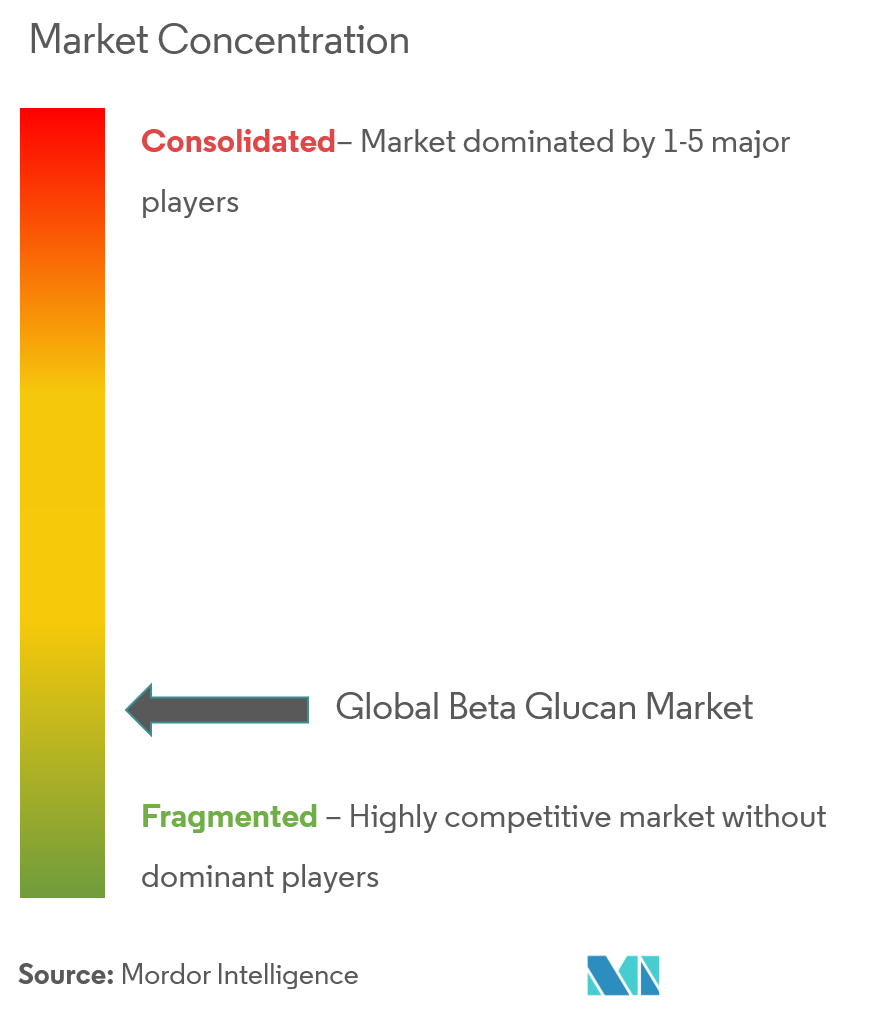
Beta Glucan Market News
In June 2021- Lantmännen had announced the launch of PromOat Gluten-Free Organic, the newest addition to its PromOat family of oat beta-glucan ingredients. Launched in response to the strong growth in consumer demand for oat-based products, which are both gluten-free and organic, this latest version of PromOat becomes the fourth member of Lantmännen's PromOat product portfolio.
In Oct 2020-Ceapro Inc. announced Additional Funding for Innovative PGX Technology Project. The additional funding includes an additional task to the Innovative PGX Technology Project related to the development of PGX yeast beta glucan (PGX-YBG) as an inhalable therapeutic for the COVID-19 patients.
In March 2019- Lesaffre completed the full acquisition of Gnosis, an Italian biotechnology company. As a result, Gnosis and LHC (Lesaffre Human Care which is the producer of beta-glucan) combined into a single team and a single business unit named Gnosis.
Beta Glucan Market Report - Table of Contents
1. INTRODUCTION
- 1.1 Study Assumptions and Market Definition
- 1.2 Scope of the Study
2. RESEARCH METHODOLOGY
3. EXECUTIVE SUMMARY
4. MARKET DYNAMICS
- 4.1 Market Drivers
- 4.2 Market Restraints
-
4.3 Porters Five Force Analysis
- 4.3.1 Threat of New Entrants
- 4.3.2 Bargaining Power of Buyers
- 4.3.3 Bargaining Power of Suppliers
- 4.3.4 Threat of Substitute Products
- 4.3.5 Intensity of Competitive Rivalry
5. MARKET SEGMENTATION
-
5.1 By Category
- 5.1.1 Soluble
- 5.1.2 Insoluble
-
5.2 By Application
- 5.2.1 Food and Beverage
- 5.2.1.1 Dairy
- 5.2.1.2 Snacks
- 5.2.1.3 Beverages
- 5.2.1.4 Confectionery
- 5.2.1.5 Baked Goods
- 5.2.1.6 Other Food and Beverages
- 5.2.2 Healthcare and Dietary Supplements
- 5.2.2.1 Infant Nutrition
- 5.2.2.2 Dietary Supplements
- 5.2.3 Other Applications
-
5.3 By Source
- 5.3.1 Fungi
- 5.3.1.1 Yeast
- 5.3.1.2 Mushroom
- 5.3.2 Cereals
- 5.3.3 Other Sources
-
5.4 Geography
- 5.4.1 North America
- 5.4.1.1 United States
- 5.4.1.2 Canada
- 5.4.1.3 Mexico
- 5.4.1.4 Rest of North America
- 5.4.2 Europe
- 5.4.2.1 Germany
- 5.4.2.2 United Kingdom
- 5.4.2.3 Italy
- 5.4.2.4 Spain
- 5.4.2.5 Russia
- 5.4.2.6 Rest of Europe
- 5.4.3 Asia-Pacific
- 5.4.3.1 China
- 5.4.3.2 Japan
- 5.4.3.3 India
- 5.4.3.4 Australia
- 5.4.3.5 Rest of Asia Pacific
- 5.4.4 South America
- 5.4.4.1 Brazil
- 5.4.4.2 Argentina
- 5.4.4.3 Rest of South America
- 5.4.5 Middle East & Africa
- 5.4.5.1 South Africa
- 5.4.5.2 Saudi Arabia
- 5.4.5.3 Rest of Middle East & Africa
6. COMPETITIVE LANDSCAPE
- 6.1 Most Active Companies
- 6.2 Most Adopted Strategies
- 6.3 Market Share Analysis
-
6.4 Company Profiles
- 6.4.1 Lantmannen
- 6.4.2 Kerry Group PLC
- 6.4.3 Koninklijke DSM NV
- 6.4.4 Super Beta Glucan Inc.
- 6.4.5 Lallemand Inc.
- 6.4.6 Ceapro Inc.
- 6.4.7 Merck KGaA
- 6.4.8 Lesaffre International
- 6.4.9 Kemin Industries
- 6.4.10 Vesta Ingredients Inc.
- 6.4.11 InVivo Group
- 6.4.12 Givadaun SA
- *List Not Exhaustive
7. MARKET OPPURTINITIES AND FUTURE TRENDS
8. IMPACT OF COVID 19 ON THE MARKET
** Subject To AvailablityBeta Glucan Industry Segmentation
Beta-glucans are biologically active fibers derived from the cell wall of various natural sources, including yeast, mushroom, oats, barley, and others, with the proven benefits for health and medical significance. The beta-glucan market is segmented by category into soluble and insoluble and by application into food and beverage, healthcare and dietary supplements, and other applications. The food and beverage segment is further bifurcated into dairy, snacks, beverages, confectionery, baked goods, and other products, and the healthcare and dietary supplements into infant nutrition and other dietary and supplements. By source, the market is segmented into cereals, yeast, mushroom, and other sources. By geography, the market is segmented into North America, Europe, Asia-Pacific, South America, and the Middle East and Africa. For each segment, the market sizing and forecasting have been done in value terms of USD million.
Beta Glucan Market Research FAQs
How big is the Beta Glucan Market?
The Beta Glucan Market size is expected to reach USD 602.54 million in 2024 and grow at a CAGR of 7.91% to reach USD 881.64 million by 2029.
What is the current Beta Glucan Market size?
In 2024, the Beta Glucan Market size is expected to reach USD 602.54 million.
Who are the key players in Beta Glucan Market?
Tate & Lyle, Lantmännen, Kerry Group , Koninklijke DSM N.V. and Givaudan S.A. are the major companies operating in the Beta Glucan Market.
Which is the fastest growing region in Beta Glucan Market?
Asia Pacific is estimated to grow at the highest CAGR over the forecast period (2024-2029).
Which region has the biggest share in Beta Glucan Market?
In 2024, the Europe accounts for the largest market share in Beta Glucan Market.
What years does this Beta Glucan Market cover, and what was the market size in 2023?
In 2023, the Beta Glucan Market size was estimated at USD 558.37 million. The report covers the Beta Glucan Market historical market size for years: 2019, 2020, 2021, 2022 and 2023. The report also forecasts the Beta Glucan Market size for years: 2024, 2025, 2026, 2027, 2028 and 2029.
Beta Glucan Industry Report
Statistics for the 2024 Beta Glucan market share, size and revenue growth rate, created by Mordor Intelligence™ Industry Reports. Beta Glucan analysis includes a market forecast outlook to 2029 and historical overview. Get a sample of this industry analysis as a free report PDF download.



